First of all let me apologize for not updating this site in a very long time, it’s actually been 4 years already (wow!). Time flies, especially so when you work a hectic job and barely have any time to relax and think. Not a good way to live, especially for a sailor. That situation has fortunately improved as of late so here I am!
After moving to Malta I talked myself into buying a Moody 346. It seemed like a good oceangoing liveaboard, which I guess is true even though I didn’t sail her all that much in the end. The longest trip was when I sailed her from Greece to Malta in 2017. That ended up being a mistake, I should’ve just left her in Greece. I ended up having a number of bad experiences in Malta in regards to boating and only a few positive ones. Long story short, after an engine seizure I ended up selling the Moody last summer. I also switched from being an employee to consultancy, giving me a lot more time and freedom. Thanks to this I decided to move to the Canary Islands together with my girlfriend (who is Canarian) and I’m loving it so far!
Spontaneous boat hunting
Back while still in Malta we were considering various options as to how/where we would want to live. One of the ideas was that instead of wasting money on renting an apartment in the Canaries we could just buy a sailboat and live aboard, while preparing for longer voyages. After a quick search we weren’t able to find anything particularly interesting so the idea was shelved for the time being.
Then one random lazy Sunday morning I started thinking… I bought my first sailboat from Sweden and they have a huge market for second hand boats over there, for very good prices. Combined with the fact that when I bought the aluminium pole to use as a mast for my first boat my dad bought one as well, to have one just in case. This to-be mast is still at my parents place in Finland so I figured why not fly to Sweden, buy a boat there, sail it over to Finland, convert to JR and then sail south? Brilliant!
So I browsed to Blocket.se and started looking around. It didn’t take very long before a Laurin 28 caught my eyes. The boat’s name got my heart racing – Tua-Tua… Really, could it possibly be..? I recalled the legendary Göran Cederström who was the first Swede to ever circumnavigate solo. He did it in the 70’s, with an L28 named Tua-Tua and wrote a great book about it, “Från hav till hav”, which I happened to had read some 10 years ago. I immediately sent the owner a message and after a few exchanges I asked whether I could pay a deposit as a reservation while I arrange flights to Sweden. And so it went. I found the ad on the 16th of June and on the 4th of July we landed in Sweden with my girlfriend, on our way to meet Tua-Tua in real life.

The beautiful Swedish archipelago as seen from the plane (seems like we’re looking down at Tvären)
Meet Tua-Tua
My brother flew in and met us two days later and we spent some lovely days in Sweden getting the boat ready to launch. The owners, a young couple named Pontus and Malee, were very friendly and welcoming and passionately shared stories of their voyage with Tua-Tua. They had bought her in 2010 and did a complete refit back then, disassembling the whole interior and reassembling it, making improvements and buying new equipment along the way. Pictures of the refit can be found on their blog (in Swedish). Once the refit was done in 2011 (impressively quickly I might add) they sailed south from Sweden, ended up visiting Morocco for a bit before heading down to the Canaries and finally across the Atlantic to the Caribbean. Shortly after arriving there they discovered that Malee was pregnant. They had initially planned on continuing to the Pacific and beyond but with these news they changed their plans and after cruising the Caribbean for a while they flew back home to Sweden. Later on some friends of theirs sailed Tua-Tua back home, where she had been standing in Pontus’ and Malee’s backyard since. To illustrate how awesomely welcome we felt, Pontus offered us to borrow his car so that we could drive around shopping for tools and supplies.
Most places we’ve gone there’s been someone who’s come up to us and asked “Is this THE Tua-Tua?”
Laurin 28 (a.k.a. L28) key stats (more here)
LOA: 8.34 m
LWL: 7.32 m
Beam: 2.50 m
Draft: 1.35 m
Disp: 3300 kg
In addition to this, one very important factor is that she’s built like a tank, with thick GRP. Even the coach roof is super solid. She was designed by Arvid Laurin, a very well-known Swedish naval architect.
The production of the L28 started in 1966 and Tua-Tua is in fact the second L28 ever built. Göran Cederström was the second owner (from 1969 to 1995) and we’re now the 6th.
We spent some really nice days there getting Tua-Tua ready for the crossing to Finland, the weather was great for the second half of the stay there. After about a week of work we were on our way sailing towards Finland!
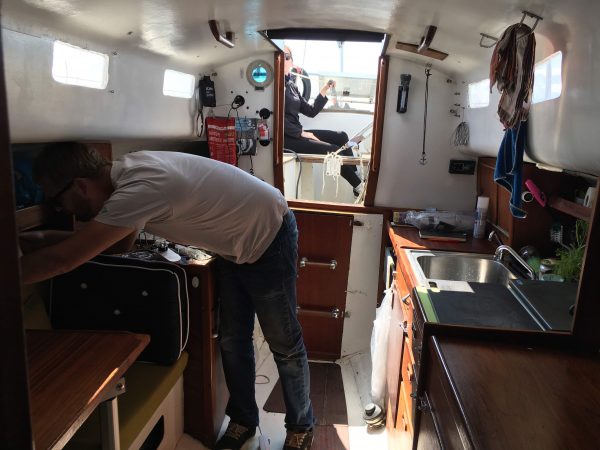
Picture of the interior looking aft. My brother reaching for something (beer?) and my girlfriend at the helm
So the plan was all along to convert to JR. The previous owners had inherited a large wardrobe of sails, I believe Tua-Tua came with 11 different sails when they bought her. Then when they sailed to the Caribbean they started using the ones in the worst condition and then just discarded them one by one as they broke down. When we bought her she only had 4 sails left (main, genoa, a yankee and a stormsail) and only the yankee and storm sail were in good condition. Needless to say I wasn’t planning on spending any money on completely new sails (and replace rigging where needed), so junk rig would be a no-brainer! And it was going to be a wingsail this time, finally. This was something I had been thinking of and planning since 2014, although it never materialized due to time constraints.
However, there was a problem. The interior layout is nice as it is and since we require a double bunk this meant that the normal placement of a mast (which generally ends up in the middle of the forepeak) would be out of the question. So I started drawing up various rigs, toying around with different multi-masted configurations, but I wasn’t able to come up with anything satisfying. This was frustrating and at one point I even (briefly) considered keeping the bermudian rig.
Proa, a slight detour bringing new ideas
For some reason during the autumn I happened to start looking into proas. As often is the case with me I got obsessed and ended up spending 2-3 weeks more or less completely immersed in the study of proas, reading up on everything I could find and watched everything available on Youtube. I had done this a couple of years ago as well, but back then my enthusiasm stopped when I realized that the rig would probably be quite complicated (and/or expensive) and I wasn’t able to figure out a great solution at the time. This time around though I was aware of the aerojunk as well as the split junk rig as potential solutions, with both rigs having high balance area (sail area in front of the mast), so I started looking into them and realized they might not only solve the rig problem on proas but also my rig problem on Tua-Tua! I might actually do a writeup on proas later, I think it’s a very fascinating boat type. This coming from someone who has never really cared for multihulls. If you watch the below video of Russ Brown’s proa Jzerro and it doesn’t make you at least a little bit excited there’s probably something wrong with you.
Not a wingsail, what then?
So… there are basically two rig candidates that I’m considering now with the intent of keeping the mast in its current position. Doing this requires a high balance (ratio of sail area in front of the mast) rig. Most junk rigs have something in the range of 10-20% in front of the mast, whereas the Aerojunk and the SJR (split junk rig) have between 30-35%. This means that their CE (center of effort) is further ahead than their traditional junk rigs or wingsail counterparts, allowing the mast position to be kept in the same position as the original rig. With a deck stepped mast you’re usually screwed either way, but since Tua-Tua has a keel-stepped (GRP by the way) mast the accommodation is designed with the mast being part of the interior.
In case you aren’t familiar with either of the rigs, here’s a quick overview.
Aerojunk
The Aerojunk is like a Balestron rig, except it’s “junkified”, having full length wishbone battens giving it similar characteristics to a junk rig. The basic concept is that both the main and the jib share the same boom and are thus always optimally sheeted compared to one another. Apologies if this description is faulty or incorrect, I honestly haven’t looked into this rig that much, but as a concept it sounds promising. The downside would be that the wishbone battens are more complicated to build, especially since they would need to be safe for offshore use. The foolproof sail in this regard would be the SJR, hence let me present to you the next high balance candidate.
SJR (Split junk rig)
The SJR is an interesting fork/variation or a more traditional cambered junk sail. The main idea is to split the sail into two – the “main” and the “jiblets”, with a slot in between, to allow for same positive “slot effect” interaction that a bermudan jib + main has. This is what the Aerojunk does as well, but the SJR keeps a strong KISS principle in mind and doesn’t include complicated parts like the wishbone battens (which have incidentally also plagued past wingsail designs).
You can read more about the SJR on the Junk Rig Association website. There’s also an article in Practical Boat Owner covering the rig.
As for the choice between the Aerojunk and the SJR there’s no doubt in my mind that I’d go for the latter, more simplistic rig.
And as mentioned before, my preferred rig would be a junk-based wingsail but the problem is that this would have its mast in the middle of the forepeak, which we’re really trying to avoid at this point.
So this is one of two major projects I’d like to undertake with Tua-Tua next summer. The second one is the engine.
To engine or not to engine?
One serious problem Tua-Tua has is that while she has a good 12 hp inboard diesel, it’s nearly impossible to access for maintenance or otherwise. The front is accessed by removing the companionway steps and the gap is frustratingly narrow. To access the back of the engine in order to access batteries, filters, propshaft/gearbox, you have to go down through the lazarette and then perform acrobatics like some kind of contortionist. By the time you’re at the engine you will be in a highly non-natural position wondering whether you’re ever going to be able to get back out. If my girlfriend was a diesel mechanic (or wanted to become one) we might be able to live with it but that’s not going to happen. I have no idea how the previous owners have put up with it. We found some “cave paintings” down below, a clear sign of someone having to have spent way too much time down there.
Having strongly considered going completely engineless in the past I have come to the sane conclusion that I do want some kind of mechanic propulsion. With a lot of planning and patience I have no doubt that you can get by with just a sculling oar or a yuloh (check out this guy on Youtube for example, or read about Peter Tangvald), but it restricts your cruising ground as well as your schedule and flexibility.
On my first boat I had a transom-hung outboard, which worked fine in normal weather but was troublesome in a seaway. One particular event I remember was sailing into Mariehamn with the wind dying out in the evening, with a swell still going on. While we were entering a somewhat narrow channel there was also a large ferry coming in at the same time and we had trouble getting out of their way under sail so we decided to play it safe and lower and start the outboard. The prop had a tendency to come out of the water while the bow pithced down, and vice versa the engine almost submerged. Normally this isn’t a huge issue (planning planning planning) but Tua-Tua brings another disadvantage by being a double ender – there’s really no great place to mount an outboard. Mounting it offset on the side would be the only reasonable way but then I’m afraid that rolling would be similar to the pitching, as in alternating between bringing the prop out of the water and submerging the engine. My brother had a genius solution to the latter – just wrap the engine in a plastic bag!
With my first boat I rarely used the outboard at all, always anchored under sail and usually slipped in and out of my berth under sails alone (with the help of an oar) unless the wind direction was awkward. The engine was highly useful for crossing shipping lanes when the wind died out though.
So we’re left with a couple of options:
1. Inboard electric
Since we’re converting to JR, why not convert to electric while at it?
Pros:
• Virtually maintenance-free
• Silent
• Responsive (starts immediately, instant full torque)
• Doesn’t require dinosaur juice
• Weight of batteries can be effectively distributed
• No flammable liquids required onboard
Cons:
• Expensive (batteries + charging) if long range is required
The only con on the list is a major one to consider.
2. Remove the cockpit footwell (flush with the seats) and keep the diesel
Pros:
• Space to work on the engine
• Safety in rough weather (getting pooped)
Cons:
• Lowers resale value (but JR conversion will do that in any case, not a real consideration)
As I have mentioned in previous posts and also discussed in some detail here I’m a big fan of not having a cockpit so I see zero cons with this approach (the con being that others might).
3. Replace with outboard engine
Pros:
• Inexpensive
• Easy maintenance
• Easy to replace anywhere anytime
• Combined with 2 (removing the footwell) would gain lots of space inside
• Get rid of prop+shaft (no leaking & improved sailing performance)
Cons:
• Horrible in a seaway with the prop coming out of the water
• Aesthetically non-pleasing
• Requires to store highly flammable, potentially explosive fuel
4. Yuloh or sculling oar
Pros:
• Very inexpensive
• Healthy / good exercise
• No explosive fuels, no dragging appendices, no added weight
Cons:
• Doesn’t do much good unless you have calm seas
• Speed and range are quite limited (1-2 knots, couple of nautical miles)
At this point I’m torn between 1 and 2. Due to the hull shape (double-ender) an outboard well isn’t really an option, otherwise 3 would be almost a no-brainer. The huge downside to 1 is the cost, which would be around the same amount the boat cost in the first place.
If the L28 somehow allowed for an outboard well then that would without a doubt be my number one choice. That takes care of aesthetics, gives the option to raise the engine and closing the well, presenting a smooth bottom to the sea. But with the double-ended hull and outboard rudder it’s somewhat problematic. The only placement would be offset on the side. Ugly, although functional (easy to get to, the L28 has quite low freeboard). All in all not an attractive option.
I see little point in having a large cockpit in the first place. There are arguments to be made for a footwell, for a more comfortable position to sit and steer for longer times, but it doesn’t have to be big. So I will probably do 2 whatever else I choose. Right now I’m leaning towards just 2, keeping the diesel operational by making it easier to access. I can then later replace the diesel with either an electric or an outboard motor.
Another advantage of removing the cockpit footwell is that the space below (without an engine) be enough for a proper double bunk, which would in turn free up the forepeak for a mast, if I at some point for example wanted to switch to a wingsail (or a more traditional junk for whatever reason).
Finishing off with some random images from the Sweden-Finland trip:
[rl_gallery id=”1363″]
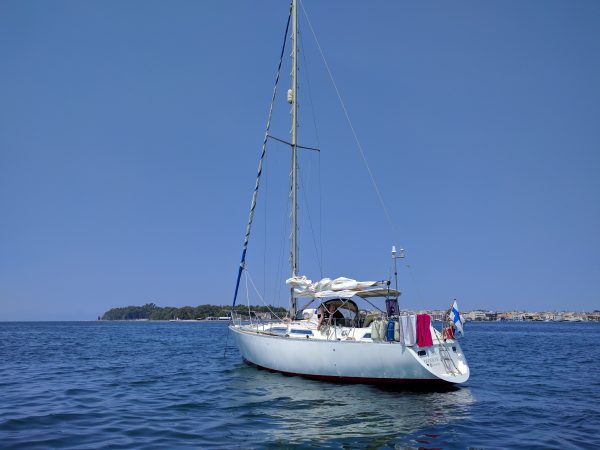


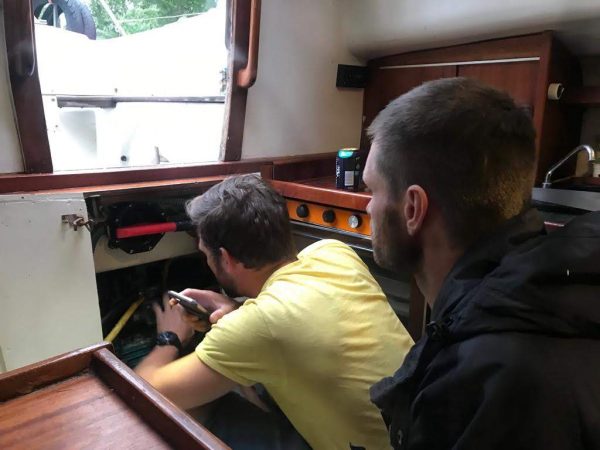
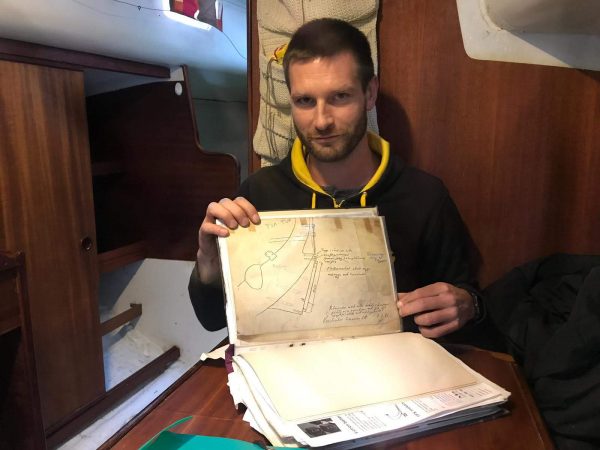
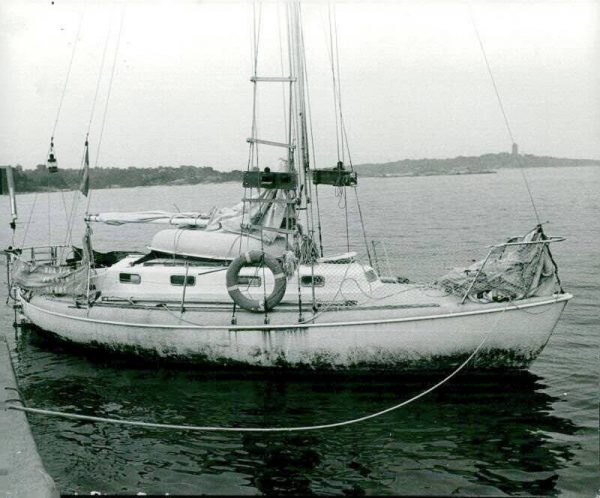
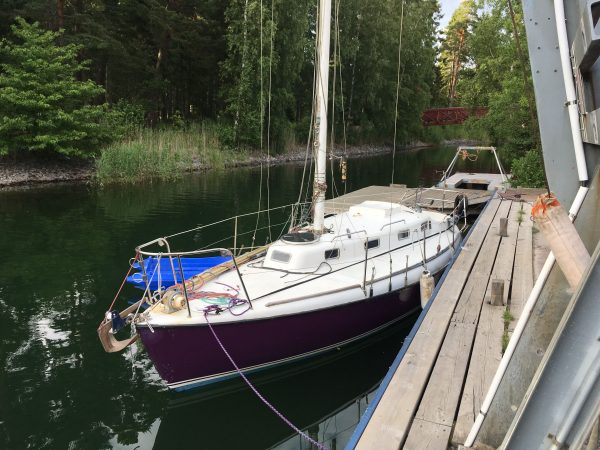

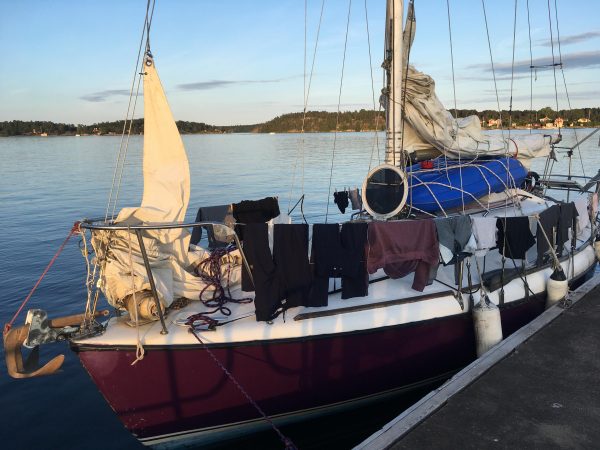
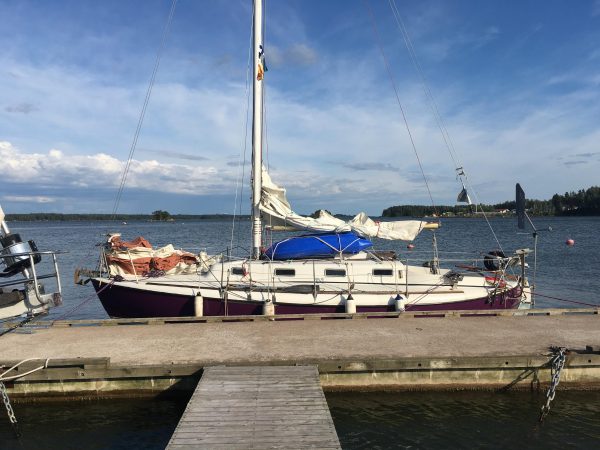
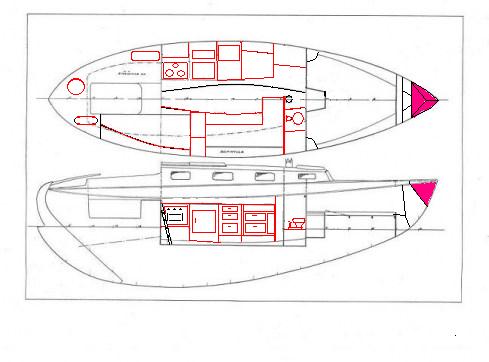


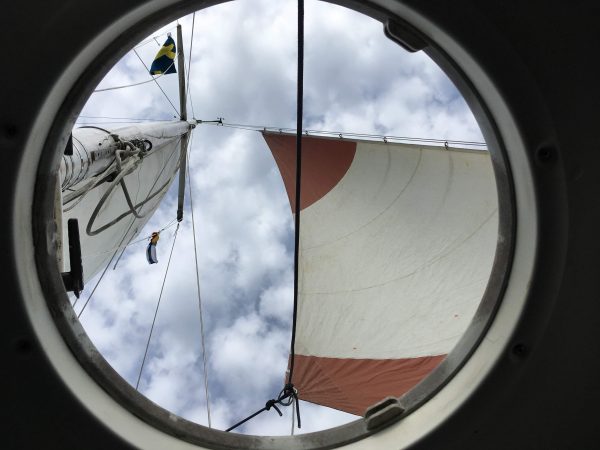
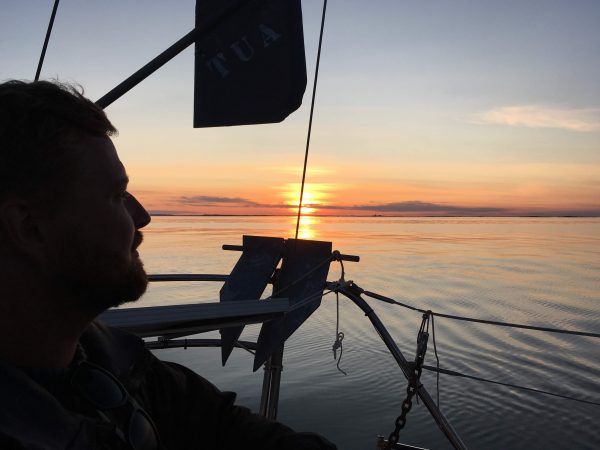

Hi, I just happened to surf on L28 sites, when reading about you and Tua Tua. A fellow in our homeport Cuxhaven happens to do up a L28 also. He wants to change the existing electric engine for a diesel he has just bought. Maybe this is an opportunity for you to get one cheap!?
I also have pictures of Peter Tangvald and family, when leaving Tenerife in Arthemis for the Caribbean. Peter was frequently aboard my boat Anna, a small Colin Archer replica I was travelling on at that time. Please give note, if interested!
Unfortunately the diesel is already sold.
Very interested in the pictures, please do send! [email protected]